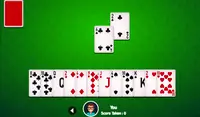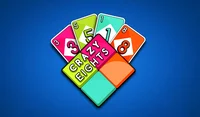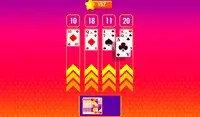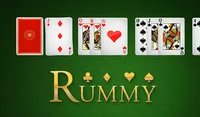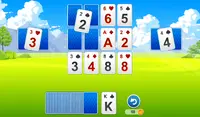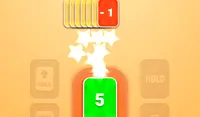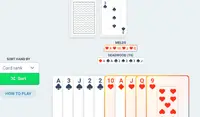Sorry... this game is not playable in your browser.


This Flash game is currently not playable in your browser, but we're working on a fix! Come back regularly to see if it's ready to play.
Most browsers no longer support Flash. Affected games are indicated by





Game content reviewed byPao Salcedo
Instructions
The goal of Cribbage is to be the first player to reach the target score of 121 points. The game has three distinct phases, which are repeated until there is a winner. Use your mouse to choose and play cards during the three phases.
Phases of Cribbage
Cribbage is broken down into three separate phases — The Deal, The Play, and The Show. Every single phase has its own unique properties and must be well understood.Cribbage is broken down into three separate phases — The Deal, The Play, and The Show. Every single phase has its own unique properties and must be well understood.
Phase 1: The Deal
At the start of the game, each player is dealt 5 or 6 cards, depending on how many players there are. Each player must choose 1-2 cards (depending on how many players there are) to send to the "crib", which belongs to the dealer. The crib is the dealer's second hand -- it will award the dealer additional points when scores are tallied.
Phase 2: The Play
Players take turns playing one card at a time from their hand onto the table. The sum of the cards played is kept track of during the round and must stay below 31. Players can earn points with sequences, pairs, and by getting the sum to 15.
The goal is to keep a running total of the card values while ensuring the combined value never exceeds 31. Face cards (King, Queen, Jack) are worth 10 points, Aces are worth 1 point, and all other cards are worth their face value. Players can score points during this phase by forming specific combinations, or scoring a certain number of points. Click on the "Scoring System" button at the bottom of the screen for a full overview.
Phase 3: The Show
After all players have emptied their hands during the play, the scores are counted. The dealer is always counted last and will also receive points for their crib.
Cribbage Strategies
There is a lot you can do to control your odds of success in cribbage. While it can seem complicated at first, you will eventually become much more comfortable with playing. Just follow these steps and you should get off to a strong start.
Take the peg seriously
As we mentioned before, the peg is the step before players reveal their hands to each other. This step is crucial, as players can gain 3, 4, or even 5 points during this phase of Cribbage. While this doesn’t sound like a lot, it often ends up becoming the difference between winning and losing.
One of the best pieces of advice we have when pegging is to try and do everything you can from allowing your opponent to get to 15 or 31, as this will result in them getting 2 points. For example, never play a card that results in the peg adding up to 21. Your opponent is likely to have a card that is worth 10 points which will allow them to get to 31, resulting in 2 points for your opponent.
Think about the cut
Selecting a hand can be difficult at first. You must try to focus on combinations with a lot of opportunities that can yield good cuts. For example, if you have a hand with a 3, 4, 5, and 6, any of these cards can form a double run if a matching card is revealed in the cut.
Dealer goes last
When recording Cribbage scores, it is important to know that the dealer records their score last. This may seem like a small detail, but it can actually become extremely important down the line. When games are coming down to the wire, knowing who is dealing can greatly influence how aggressively you peg.
Don’t throw a 5 in the crib
This one may seem obvious, but throwing a 5 into the crib when it is your opponent's deal is almost never a good idea. The most common cards to throw away into the crib are cards worth ten points, such as the Jack, Queen, and King. When these are matched with a 5, they will give your opponent a 15 and reward them with an automatic 2 points.
The goal of Cribbage is to be the first player to reach the target score of 121 points. The game has three distinct phases, which are repeated until there is a winner. Use your mouse to choose and play cards during the three phases.
Phases of Cribbage
Cribbage is broken down into three separate phases — The Deal, The Play, and The Show. Every single phase has its own unique properties and must be well understood.
Phase 1: The Deal
At the start of the game, each player is dealt 5 or 6 cards, depending on how many players there are. Each player must choose 1-2 cards (depending on how many players there are) to send to the "crib", which belongs to the dealer. The crib is the dealer's second hand -- it will award the dealer additional points when scores are tallied.
Phase 2: The Play
Players take turns playing one card at a time from their hand onto the table. The sum of the cards played is kept track of during the round and must stay below 31. Players can earn points with sequences, pairs, and by getting the sum to 15.
The goal is to keep a running total of the card values while ensuring the combined value never exceeds 31. Face cards (King, Queen, Jack) are worth 10 points, Aces are worth 1 point, and all other cards are worth their face value. Players can score points during this phase by forming specific combinations, or scoring a certain number of points. Click on the "Scoring System" button at the bottom of the screen for a full overview.
Phase 3: The Show
After all players have emptied their hands during the play, the scores are counted. The dealer is always counted last and will also receive points for their crib.
Cribbage Strategies
There is a lot you can do to control your odds of success in Cribbage. While it can seem complicated at first, you will eventually become much more comfortable with playing. Just follow these steps and you should get off to a strong start.
Take the peg seriously
As we mentioned before, the peg is the step before players reveal their hands to each other. This step is crucial, as players can gain 3, 4, or even 5 points during this phase of Cribbage. While this doesn’t sound like a lot, it often ends up becoming the difference between winning and losing.
One of the best pieces of advice we have when pegging is to try and do everything you can from allowing your opponent to get to 15 or 31, as this will result in them getting 2 points. For example, never play a card that results in the peg adding up to 21. Your opponent is likely to have a card that is worth 10 points which will allow them to get to 31, resulting in 2 points for your opponent.
Think about the cut
Selecting a hand can be difficult at first. You must try to focus on combinations with a lot of opportunities that can yield good cuts. For example, if you have a hand with a 3, 4, 5, and 6, any of these cards can form a double run if a matching card is revealed in the cut.
Dealer goes last
When recording Cribbage scores, it is important to know that the dealer records their score last. This may seem like a small detail, but it can actually become extremely important down the line. When games are coming down to the wire, knowing who is dealing can greatly influence how aggressively you peg.
Don’t throw a 5 in the crib
This one may seem obvious, but throwing a 5 into the crib when it is your opponent's deal is almost never a good idea. The most common cards to throw away into the crib are cards worth ten points, such as the Jack, Queen, and King. When these are matched with a 5, they will give your opponent a 15 and reward them with an automatic 2 points.
What does it mean to get skunked?
Getting skunked is when someone is defeated before they reach 91 points. This is considered to be the equivalent of losing 2 games.
If a player fails to reach 61 points, they are double skunked. This is the equivalent of losing 3 games in one round. While it is extremely rare to see a double skunk, they do happen. It usually takes some large mistakes from one player, while the other player executes their game plan perfectly. Of course, there is also a major luck component when it comes to having a point deficit that large.
What is nobs and nibs in cribbage?
One of the lesser-known rules of Cribbage are the nobs and the nibs. They are both related to the Jack, an otherwise ordinary card in this game.
The nobs refer to when players have a Jack in their hand. If the cut is the same suit as the Jack, players are awarded one extra point during the The Show. For example, if you have a Jack of diamonds in your hand, and a Four of diamonds is cut, you will gain one point for that.
The nibs portion is a little bit more straightforward. When the dealer cuts, they are awarded 2 points if it is a Jack of any suit. This rule isn’t widely known in the Cribbage community, but it is definitely an important part of the game.
Just a moment while your advertisement loads
Advertisement
Just a moment while your advertisement loads
Advertisement
Game content reviewed byPao Salcedo
Instructions
The goal of Cribbage is to be the first player to reach the target score of 121 points. The game has three distinct phases, which are repeated until there is a winner. Use your mouse to choose and play cards during the three phases.
Phases of Cribbage
Cribbage is broken down into three separate phases — The Deal, The Play, and The Show. Every single phase has its own unique properties and must be well understood.Cribbage is broken down into three separate phases — The Deal, The Play, and The Show. Every single phase has its own unique properties and must be well understood.
Phase 1: The Deal
At the start of the game, each player is dealt 5 or 6 cards, depending on how many players there are. Each player must choose 1-2 cards (depending on how many players there are) to send to the "crib", which belongs to the dealer. The crib is the dealer's second hand -- it will award the dealer additional points when scores are tallied.
Phase 2: The Play
Players take turns playing one card at a time from their hand onto the table. The sum of the cards played is kept track of during the round and must stay below 31. Players can earn points with sequences, pairs, and by getting the sum to 15.
The goal is to keep a running total of the card values while ensuring the combined value never exceeds 31. Face cards (King, Queen, Jack) are worth 10 points, Aces are worth 1 point, and all other cards are worth their face value. Players can score points during this phase by forming specific combinations, or scoring a certain number of points. Click on the "Scoring System" button at the bottom of the screen for a full overview.
Phase 3: The Show
After all players have emptied their hands during the play, the scores are counted. The dealer is always counted last and will also receive points for their crib.
Cribbage Strategies
There is a lot you can do to control your odds of success in cribbage. While it can seem complicated at first, you will eventually become much more comfortable with playing. Just follow these steps and you should get off to a strong start.
Take the peg seriously
As we mentioned before, the peg is the step before players reveal their hands to each other. This step is crucial, as players can gain 3, 4, or even 5 points during this phase of Cribbage. While this doesn’t sound like a lot, it often ends up becoming the difference between winning and losing.
One of the best pieces of advice we have when pegging is to try and do everything you can from allowing your opponent to get to 15 or 31, as this will result in them getting 2 points. For example, never play a card that results in the peg adding up to 21. Your opponent is likely to have a card that is worth 10 points which will allow them to get to 31, resulting in 2 points for your opponent.
Think about the cut
Selecting a hand can be difficult at first. You must try to focus on combinations with a lot of opportunities that can yield good cuts. For example, if you have a hand with a 3, 4, 5, and 6, any of these cards can form a double run if a matching card is revealed in the cut.
Dealer goes last
When recording Cribbage scores, it is important to know that the dealer records their score last. This may seem like a small detail, but it can actually become extremely important down the line. When games are coming down to the wire, knowing who is dealing can greatly influence how aggressively you peg.
Don’t throw a 5 in the crib
This one may seem obvious, but throwing a 5 into the crib when it is your opponent's deal is almost never a good idea. The most common cards to throw away into the crib are cards worth ten points, such as the Jack, Queen, and King. When these are matched with a 5, they will give your opponent a 15 and reward them with an automatic 2 points.
What does it mean to get skunked?
Getting skunked is when someone is defeated before they reach 91 points. This is considered to be the equivalent of losing 2 games.
If a player fails to reach 61 points, they are double skunked. This is the equivalent of losing 3 games in one round. While it is extremely rare to see a double skunk, they do happen. It usually takes some large mistakes from one player, while the other player executes their game plan perfectly. Of course, there is also a major luck component when it comes to having a point deficit that large.
What is nobs and nibs in cribbage?
One of the lesser-known rules of Cribbage are the nobs and the nibs. They are both related to the Jack, an otherwise ordinary card in this game.
The nobs refer to when players have a Jack in their hand. If the cut is the same suit as the Jack, players are awarded one extra point during the The Show. For example, if you have a Jack of diamonds in your hand, and a Four of diamonds is cut, you will gain one point for that.
The nibs portion is a little bit more straightforward. When the dealer cuts, they are awarded 2 points if it is a Jack of any suit. This rule isn’t widely known in the Cribbage community, but it is definitely an important part of the game.
The goal of Cribbage is to be the first player to reach the target score of 121 points. The game has three distinct phases, which are repeated until there is a winner. Use your mouse to choose and play cards during the three phases.
Phases of Cribbage
Cribbage is broken down into three separate phases — The Deal, The Play, and The Show. Every single phase has its own unique properties and must be well understood.
Phase 1: The Deal
At the start of the game, each player is dealt 5 or 6 cards, depending on how many players there are. Each player must choose 1-2 cards (depending on how many players there are) to send to the "crib", which belongs to the dealer. The crib is the dealer's second hand -- it will award the dealer additional points when scores are tallied.
Phase 2: The Play
Players take turns playing one card at a time from their hand onto the table. The sum of the cards played is kept track of during the round and must stay below 31. Players can earn points with sequences, pairs, and by getting the sum to 15.
The goal is to keep a running total of the card values while ensuring the combined value never exceeds 31. Face cards (King, Queen, Jack) are worth 10 points, Aces are worth 1 point, and all other cards are worth their face value. Players can score points during this phase by forming specific combinations, or scoring a certain number of points. Click on the "Scoring System" button at the bottom of the screen for a full overview.
Phase 3: The Show
After all players have emptied their hands during the play, the scores are counted. The dealer is always counted last and will also receive points for their crib.
Cribbage Strategies
There is a lot you can do to control your odds of success in Cribbage. While it can seem complicated at first, you will eventually become much more comfortable with playing. Just follow these steps and you should get off to a strong start.
Take the peg seriously
As we mentioned before, the peg is the step before players reveal their hands to each other. This step is crucial, as players can gain 3, 4, or even 5 points during this phase of Cribbage. While this doesn’t sound like a lot, it often ends up becoming the difference between winning and losing.
One of the best pieces of advice we have when pegging is to try and do everything you can from allowing your opponent to get to 15 or 31, as this will result in them getting 2 points. For example, never play a card that results in the peg adding up to 21. Your opponent is likely to have a card that is worth 10 points which will allow them to get to 31, resulting in 2 points for your opponent.
Think about the cut
Selecting a hand can be difficult at first. You must try to focus on combinations with a lot of opportunities that can yield good cuts. For example, if you have a hand with a 3, 4, 5, and 6, any of these cards can form a double run if a matching card is revealed in the cut.
Dealer goes last
When recording Cribbage scores, it is important to know that the dealer records their score last. This may seem like a small detail, but it can actually become extremely important down the line. When games are coming down to the wire, knowing who is dealing can greatly influence how aggressively you peg.
Don’t throw a 5 in the crib
This one may seem obvious, but throwing a 5 into the crib when it is your opponent's deal is almost never a good idea. The most common cards to throw away into the crib are cards worth ten points, such as the Jack, Queen, and King. When these are matched with a 5, they will give your opponent a 15 and reward them with an automatic 2 points.
Votes



